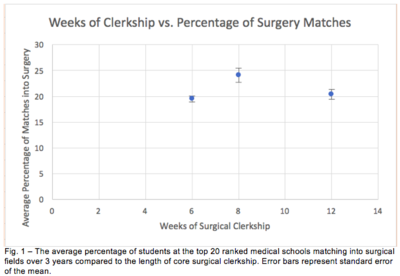C2A - 01: LENGTH OF THE CORE SURGICAL CLERKSHIP â DOES IT IMPACT ON STUDENTS SELECTING A SURGICAL RESIDENCY?
Alex J Xu, Russell S Berman, MD, Hersch L Pachter, MD, Mark S Hochberg, MD; New York University School of Medicine
BACKGROUND: The length of core surgical clerkships ranges from 6 to 12 weeks at the top U.S. medical schools. The present study examines if the length of the surgical clerkship correlates with the percentage of students that match into surgical fields defined as: general surgery, otolaryngology, orthopedic surgery, plastic surgery (integrated), neurosurgery, urology, vascular surgery (integrated), oral/maxillofacial surgery, cardiothoracic surgery (integrated), and ophthalmology.
METHODS: The study identifies the percentage of medical students at the top 20 “U.S. News and World Report – Research” ranked medical schools who matched in surgical fields. Using publicly available information including match lists, class size, and length of the core surgical clerkship, we included the most recent three years’ worth of data for each school to calculate the percentage of each class matching into surgical fields as a function of the length of the school’s surgical clerkship.
RESULTS: Of the 20 schools, two had a 6 week core surgery clerkship, eleven had an 8 week, and seven had a 12 week (six of which are ranked in the top 10). None of the top 20 schools offered a 10 week surgical clerkship. The average percentage of students ± SEM that matched into surgical fields at 6, 8, and 12 week programs were 19.5% ± 0.556, 24.1% ± 1.36, and 20.4% ± 0.977, respectively. The 95% confidence intervals do not overlap between 6 and 8 week programs nor do they overlap between 8 and 12 week programs, with 8 week programs matching a higher percentage of students into surgical fields in both cases. There is significant overlap in confidence intervals between 6 and 12 week programs.
CONCLUSION: Among the top 20 USNWR-ranked medical schools, those with a eight week surgical clerkships matched a higher percentage of students into surgical residencies compared to schools with six or twelve week surgical clerkships.

